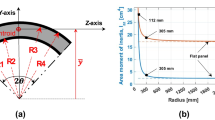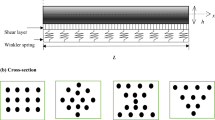Abstract
In order to improve the seismic behavior of coupled shear wall structures, a new type of post-tensioned steel truss coupling beam (PSTCB) is developed in this paper. The PSTCB is composed of chord members, two diagonal buckling-restrained energy dissipaters and diagonally placed post-tensioned tendons. The energy dissipaters are expected to serve as fuses and can be quickly repaired after earthquake. Furthermore, the residual drift of the coupling beam can be reduced by the application of post-tensioned tendons in the diagonal direction. In the PSTCB, the post-tensioned tendons are anchored at outer ends of the wall piers. According to the Chinese code, an 11-story coupled wall structure was designed and the numerical model was developed in PERFORM-3D software. The seismic behaviors of the hybrid coupled wall system with PSTCBs (HCW-P), the hybrid coupled wall system with replaceable steel truss coupling beams and concrete coupled wall system with reinforced concrete coupling beams were evaluated and compared under maximum considered earthquake. Results showed that the HCW-P can achieve excellent lateral strength, stiffness, and ductility as well as reduce the residual displacements of the structure after earthquake.
Similar content being viewed by others
References
ACI318 (2014). Building code requirements for structural concrete and commentary. ACI318, American Concrete Institute, Farmington Hills, MI, USA.
American Society of Civil Engineers (ASCE) (2013). Seismic evaluation and retrofit of existing buildings, ASCE/SEI 41-13, Reston, VA, USA.
ATC-72-1 (2010). Modeling and acceptance criteria for seismic design and analysis of tall buildings, ATC-72–1, Applied Technology Council, Redwood city, CA, USA.
CMC (2010). Code for seismic design of buildings, GB 50011–2010, China Ministry of Construction, Beijing, China (in Chinese).
El-Tawil, S. and Kuenzli, C. M. (2002). “Pushover of hybrid coupled walls. II: Analysis and behavior.” Journal of Structural Engineering, ASCE, vol. 128, no. 10, pp. 1282–1289, DOI: https://doi.org/10.1061/(ASCE)0733-9445(2002)128:10(1282).
Fortney, P. J., Shahrooz, B. M., and Rassati, G A. (2007). “Large-scale testing of a replaceable “fuse” steel coupling beam.” Journal of Structural Engineering, ASCE, vol. 133, no. 12, pp. 1801–1807, DOI: https://doi.org/10.1061/(ASCE)0733-9445(2007)133:12(1801).
Gong, B. and Shahrooz, B. M. (2001a). “Concrete-steel composite coupling beams. I: Component testing.” Journal of Structural Engineering, ASCE, vol. 127, no. 6, pp. 625–631, DOI: https://doi.org/10.1061/(ASCE)0733-9445(2001)127:6(625).
Gong, B. and Shahrooz, B. M. (2001b). “Concrete-steel composite coupling beams. II: Subassembly testing and design verification.” Journal of Structural Engineering, ASCE, vol. 127, no. 6, pp. 632–638, DOI: https://doi.org/10.1061/(ASCE)0733-9445(2001)127:6(632).
Harries, K. A., Mitchell, D., Cook, W. D., and Redwood, R. G. (1993). “Seismic response of steel beams coupling reinforced concrete walls.” Journal of Structural Engineering, ASCE, vol. 119, no. 12, pp. 3611–3629, DOI: https://doi.org/10.1061/(ASCE)0733-9445(1993)119:12(3611).
Ji, X., Wang, Y., Ma, Q., and Taichiro, O. (2017). “Cyclic behavior of replaceable steel coupling beams.” Journal of Structural Engineering, ASCE, vol. 143, no. 2, 04016169, DOI: https://doi.org/10.1061/(ASCE)ST.1943-541X.0001661.
Jiang, Z., Guo, Y., Zhang, B., and Zhang, X. (2015). “Influence of design parameters of buckling-restrained brace on its performance.” Journal of Constructional Steel Research, vol. 105, no. 2, pp. 139–150, DOI: https://doi.org/10.1016/j.jcsr.2014.10.024.
Kent, D. C. and Park, R. (1971). “Flexural members with confined concrete.” Journal of the Structural Division, ASCE, vol. 97, no. 7, pp. 1969–1990.
Li, Y., Liu, Y., and Meng, S. (2019). “Seismic performance evaluation of coupled wall system with novel replaceable steel truss coupling beams.” Advances in Structural Engineering, vol. 22, no. 12, pp. 1284–1296, DOI: https://doi.org/10.1177/1369433218811530.
Lu, X., Chen, C., Jiang, H., and Wang, S. (2018). “Shaking table tests and numerical analyses of an RC coupled wall structure with replaceable coupling beams.” Earthquake Engineering & Structural Dynamics, vol. 47, no. 9, pp. 1882–1904, DOI: https://doi.org/10.1002/eqe.3046.
Mattock, A. H. and Gaafar, G. H. (1982). “Strength of embedded steel sections as brackets.” ACI Structural Journal, vol. 79, no. 2, pp. 83–93.
McCormick, J., Aburano, H., Ikenaga, M., and Nakashima, M. (2008). “Permissible residual deformation levels for building structures considering both safety and human elements.” Proc. 14th World Conf. Earthquake Engineering, Seismological Press of China, Beijing, China, pp. 12–17.
Parker, M. and Steenkamp, D. (2012). “The economic impact of the Canterbury earthquakes.” Reserve Bank of New Zealand Bulletin, vol. 75, no. 3, pp. 13–25.
Paulay, T. (1971). “Coupling beams of reinforced concrete shear walls.” Journal of Structural Engineering, ASCE, vol. 97, no. 3, pp. 843–862.
Paulay, T. and Binney, J. R. (1974). “Diagonally reinforced coupling beams of shear walls.” ACI Special Publication, SP-42, pp. 579–598.
PEER (2013). Pacific earthquake engineering research center, Report No. 2013/03, University of California, Berkeley, CA, USA.
Saatcioglu, M. and Razvi, S. R. (1992). “Strength and ductility of confined concrete.” Journal of Structural Engineering, ASCE, vol. 118, no. 6, pp. 1590–1607, DOI: https://doi.org/10.1061/(ASCE)0733-9445(1992)118:6(1590).
Sarti, F., Palermo, A., and Pampanin, S. (2016). “Fuse-type external replaceable dissipaters: Experimental program and numerical modeling.” Journal of Structural Engineering, ASCE, vol. 142, no. 12, 04016134, DOI: https://doi.org/10.1061/(ASCE)ST.1943-541X.0001606.
Shahrooz, B. M., Remmetter, M. A. and Qin, F. (1993). “Seismic design and performance of composite coupled walls.” Journal of Structural Engineering, ASCE, vol. 119, no. 11, pp. 3291–3309, DOI: https://doi.org/10.1061/(ASCE)0733-9445(1993)119:11(3291).
Zhao, J., Wu, B., Li, W., and Ou, J. (2014). “Local buckling behavior of steel angle core members in buckling-restrained braces: cyclic tests, theoretical analysis, and design recommendations.” Engineering Structures, vol. 66, pp. 129–145, DOI: https://doi.org/10.1016/j.engstruct.2014.02.008.
Author information
Authors and Affiliations
Corresponding author
Rights and permissions
About this article
Cite this article
Li, Y., Liu, Y. A Study on Coupled Wall System with Post-tensioned Steel Truss Coupling Beams: Concept and Performance Evaluation. KSCE J Civ Eng 23, 3560–3570 (2019). https://doi.org/10.1007/s12205-019-2025-7
Received:
Accepted:
Published:
Issue Date:
DOI: https://doi.org/10.1007/s12205-019-2025-7




